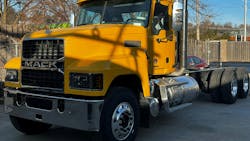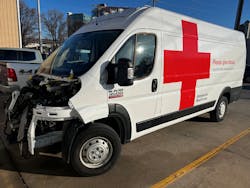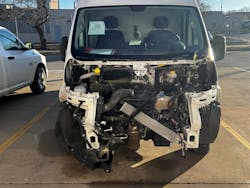People tend to think of collision repair as a recession-proof industry, that short of something unprecedented — say, a global pandemic — there is nothing to stop people from driving. And the more people drive, the more they crash into each other.
But that’s not to say that a shop’s workflow is steady and constant. The reality, of course, is that there are ebbs and flows all the time. Indeed, that’s one of the main challenges as a business owner, to smooth out those peaks and valleys as much as you can so the shop works as efficiently as possible. To this end, many shops have been turning to servicing fleet vehicles as a way to get a steadier, more predictable flow of work.
“Our industry has always been an up-and-down roller coaster, regardless if you have direct repair programs or not,” says John Melenedez, owner of JDM Collision in Thornton, Illinois. “You know, everybody goes through a low, and I figured I would like to have something that we could always rely on, and not just do it, for instance, when we did get slow.”
There are many different kinds of fleet accounts shops can secure, each with their own intricacies and considerations. But, in general, what kinds of things can shops expect when making fleet work a part of their portfolio? Think more work, but also potentially more equipment and more training. With the right preparation, however, it can be a seamless transition.
Thinking about the future
Anyone who has attended a talk from Mike Anderson in recent years will likely remember his advice — by way of hockey legend Wayne Gretzky — to skate to where the puck is going, not to where it has been. Melendez believes that fleet work is wide-open ice, and he’s maneuvered his shop in position to receive that pass. While on one hand Melendez believes there will be fewer accidents in the future due to the advancement of vehicle technology, other opportunities will be created.
“This younger generation is relying on Amazon to deliver their package, FedEx to deliver their package,” says Melendez, “And now, if you go into different dealers and network with them directly, like, General Motors, they have a deal with Lyft. Well, one of those cars gets into an accident, they’re going to say, hey, send it to this shop.”
JDM Collision is one of the few shops in the country certified to work on GM’s new BrightDrop platform of electric trucks. In development for the past three and a half years, the platform already has commercial customers such as FedEx and Ryder. It’s expected to compete with the Rivian electric trucks in use by companies like Amazon.
“I feel that the medium duty platform is an untapped market share that can truly complement a shop that wants to stay in the industry but yet be able to have something that they could enhance their business and grow,” says Melendez.
Finding the work
Bringing fleet work through the door is what Bob Gallant does every day. Gallant does marketing for Central Body Company, which has five locations across Iowa, Missouri, and Kansas. Central Body specializes in RV repair but also services fleets, such as repairing Rivian delivery vehicles. Gallant says that he starts with insurance agents, building the word of mouth that the company is the go-to place for fleet or RV repairs.
“They may not go through the 800 number like a car would do, you know, call this number in case of an accident, they may do it a little bit differently, and usually it’s because they already know who we are, and so they call us direct, and then we just handle and repair from there,” Gallant says.
The question of finding fleet work also brings up the point that there is more fleet and commercial work out there than you may think. While most people think of delivery companies, there are countless large businesses with fleets of vehicles — think rental car companies, landscaping companies, pest control companies, and even city governments. The latter is one area Melendez has targeted, and the marketing couldn’t be easier. It comes down to being a good neighbor.
One of Melendez’s initiatives was to hand out flyers at a local retirement community offering the shop as a resource for any questions residents had about their vehicles as well as basic free services like topping off the air pressure in their tires. Those things resonated throughout the community, Melendez says. That gets the shop more attention and an enhanced reputation to secure more fleet work.
“If you just do a little thing to show some empathy that you truly care about people, all the work comes from the surrounding town,” Melendez says. “They have their own fleets. They have their trucks. They have their dump trucks. I mean, there’s so much there that a shop could capture if they stay in good standing.”
Use your existing resources
Like adding any new service, you have to see the ROI opportunity at some point; it doesn’t make sense to make a huge capital outlay without a reasonable way to see that money coming back. For Gallant, Central Body Company’s RV work already made it so working on large trucks was not much of an additional ask. They did have to acquire certification to work on Rivian delivery trucks (a distinct certification from those of Rivian passenger vehicles).
“Central is probably one of the most unique of most body shops in that we work on a little bit of everything,” Gallant says. “It doesn't matter if it’s a dump truck or a trash truck, the frame machine is bigger, obviously, and just everything that we do is on a bigger scale, but the actual equipment is pretty much the same, and the processes stay the same.”
One of the ways to make fleet repairs make more financial sense is to utilize the space, equipment, and labor you already have. When Melendez was searching for a frame bench to suit his medium duty platform, he selected one — made by Celette of France—that was versatile, so he could repair passenger vehicles as well as medium duty vans and trucks. But at the same time, it’s uniquely suited to the repairs Melendez’s shop has targeted.
“This rack that I have in place is the only rack that they recognize to fix that type of platform, because it’s a true fixture bench,” Melendez says. “By doing that, this 14,000-pound rack that I have in place has the ability to do these bigger vehicles.”
Also consider your shop’s capacity. As Gallant notes, fleet customers often have the need for tight turnarounds on their repairs, as these vehicles are revenue generators. These needs can be magnified at certain times of the year as well. When FenderBender spoke to Gallant, it was the heart of the holiday season, not only at the peak for deliveries but also combined with hazardous winter driving conditions in much of the country.
“These guys are on us to get it back quickly,” Gallant says. “Basically, at this time of the year, these people need these trucks very badly because they have so much to deliver.”
About the Author
Todd Kortemeier
Todd Kortemeier is former editor of FenderBender magazine and started writing as a contributor in 2024.





